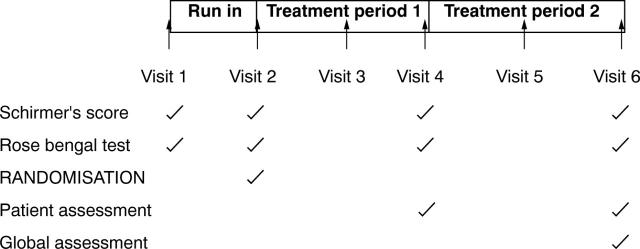Abstract
BACKGROUND/AIMS—Hyaluronan (sodium hyaluronate) has been shown to confer objective and subjective improvement in patients with dry eye syndrome. This study compared the efficacy and safety of a 0.1% solution of hyaluronan with 0.9% saline, when administered topically to the eye, in the treatment of symptoms of severe dry eye syndrome. METHODS—A randomised, double blind, crossover clinical trial in which subjects were randomised to receive either hyaluronan or saline, applied as one or two drops to the eye, three or four times a day or as required. After 28 days' treatment, subjects crossed over to the other study medication for a further 28 days' treatment. RESULTS—70 subjects were included in the analyses of efficacy and significant improvements in Schirmer's score (p=0.0006) and rose bengal staining score (p=0.0001) were observed during treatment with hyaluronan. In a subjective assessment of the effectiveness of two treatments, a majority of subjects felt that hyaluronan was more effective than saline in alleviating the symptoms of burning and grittiness (p<0.001). No adverse events attributable to hyaluronan treatment were reported. CONCLUSION—The study demonstrates a clear benefit of hyaluronan over saline, in both subjective and objective assessments of dry eye syndrome. Hyaluronan was shown to be well tolerated.
Full Text
The Full Text of this article is available as a PDF (90.3 KB).
Figure 1 .
Study design.
Selected References
These references are in PubMed. This may not be the complete list of references from this article.
- DeLuise V. P., Peterson W. S. The use of topical Healon tears in the management of refractory dry-eye syndrome. Ann Ophthalmol. 1984 Sep;16(9):823–824. [PubMed] [Google Scholar]
- Hamano T., Horimoto K., Lee M., Komemushi S. Sodium hyaluronate eyedrops enhance tear film stability. Jpn J Ophthalmol. 1996;40(1):62–65. [PubMed] [Google Scholar]
- Hills M., Armitage P. The two-period cross-over clinical trial. Br J Clin Pharmacol. 1979 Jul;8(1):7–20. doi: 10.1111/j.1365-2125.1979.tb05903.x. [DOI] [PMC free article] [PubMed] [Google Scholar]
- Mengher L. S., Pandher K. S., Bron A. J., Davey C. C. Effect of sodium hyaluronate (0.1%) on break-up time (NIBUT) in patients with dry eyes. Br J Ophthalmol. 1986 Jun;70(6):442–447. doi: 10.1136/bjo.70.6.442. [DOI] [PMC free article] [PubMed] [Google Scholar]
- Nakamura M., Hikida M., Nakano T., Ito S., Hamano T., Kinoshita S. Characterization of water retentive properties of hyaluronan. Cornea. 1993 Sep;12(5):433–436. doi: 10.1097/00003226-199309000-00010. [DOI] [PubMed] [Google Scholar]
- Nishida T., Nakamura M., Mishima H., Otori T. Hyaluronan stimulates corneal epithelial migration. Exp Eye Res. 1991 Dec;53(6):753–758. doi: 10.1016/0014-4835(91)90110-z. [DOI] [PubMed] [Google Scholar]
- Sand B. B., Marner K., Norn M. S. Sodium hyaluronate in the treatment of keratoconjunctivitis sicca. A double masked clinical trial. Acta Ophthalmol (Copenh) 1989 Apr;67(2):181–183. doi: 10.1111/j.1755-3768.1989.tb00750.x. [DOI] [PubMed] [Google Scholar]
- Shimmura S., Ono M., Shinozaki K., Toda I., Takamura E., Mashima Y., Tsubota K. Sodium hyaluronate eyedrops in the treatment of dry eyes. Br J Ophthalmol. 1995 Nov;79(11):1007–1011. doi: 10.1136/bjo.79.11.1007. [DOI] [PMC free article] [PubMed] [Google Scholar]
- Stuart J. C., Linn J. G. Dilute sodium hyaluronate (Healon) in the treatment of ocular surface disorders. Ann Ophthalmol. 1985 Mar;17(3):190–192. [PubMed] [Google Scholar]
- Tsubota K., Yamada M. Tear evaporation from the ocular surface. Invest Ophthalmol Vis Sci. 1992 Sep;33(10):2942–2950. [PubMed] [Google Scholar]
- Wysenbeek Y. S., Loya N., Ben Sira I., Ophir I., Ben Shaul Y. The effect of sodium hyaluronate on the corneal epithelium. An ultrastructural study. Invest Ophthalmol Vis Sci. 1988 Feb;29(2):194–199. [PubMed] [Google Scholar]
- Xu K. P., Yagi Y., Tsubota K. Decrease in corneal sensitivity and change in tear function in dry eye. Cornea. 1996 May;15(3):235–239. doi: 10.1097/00003226-199605000-00002. [DOI] [PubMed] [Google Scholar]
- Yokoi N., Komuro A., Nishida K., Kinoshita S. Effectiveness of hyaluronan on corneal epithelial barrier function in dry eye. Br J Ophthalmol. 1997 Jul;81(7):533–536. doi: 10.1136/bjo.81.7.533. [DOI] [PMC free article] [PubMed] [Google Scholar]
- van Bijsterveld O. P. Diagnostic tests in the Sicca syndrome. Arch Ophthalmol. 1969 Jul;82(1):10–14. doi: 10.1001/archopht.1969.00990020012003. [DOI] [PubMed] [Google Scholar]



